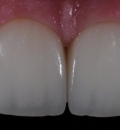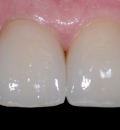Porcelain veneers
.jpg)
Porcelain veneers are very thing 0.3-0.5 mm thick porcelain plates covering the front teeth. These veneers can be made very thin so as not to prepare the tooth too much. This solution is very useful and recommended when:
- the front teeth are misaligned;
- the front teeth are discolored (non-vital teeth or teeth damaged by fluorosis or tetracycline);
- wide, unattractive spaces between teeth (diastemas);
- dark, bleaching-resistant tooth pigment;
- dental trauma, when parts of a tooth need to be restored;
- insufficient tooth height;
- many unattractive fillings.
The veneer procedure has three goals: to maximize the aesthetic effect of tooth form, color and alignment; to restore hard tissues of the tooth and to restore chewing functionality.

Compared to other tooth restoration methods, the advantages of porcelain veneers are indisputable:
- very strong bond to enamel;
- less wear than composite veneers or fillings (cosmetic fillings);
- no discoloration or loss of luster;
- less tooth tissue is removed compared to crowns or fillings;
- last for 10-12 years, compared to 3-8 years for fillings;
- well tolerated, does not cause allergies;
- even severely discolored teeth can be treated;
- it is not always possible to correct discolorations using cosmetic fillings, also they lose luster over time;
- allows for best aesthetics.
For best aesthetic results, specialists recommend ceramic veneers, even though they are more expensive than PFM crowns. It is important to know that porcelain is extremely durable, aesthetic, transparent and natural, so the investment to your appearance will pay back generously. It is also a very conservative treatment. 63-72% of tooth tissues are removed for a full crown compared to 3-30% for veneers. Porcelain veneers are custom-made in a laboratory, therefore they are indistinguishable from natural teeth. Veneers are resistant to staining by coffee, tea or smoking.
Veneer treatment usually takes 2-3 visits to the dentist. During the first visit the teeth are prepared for the procedure. It can take anywhere from 1 to 4 hours. Old restorations are removed, tooth impression is taken and the color and shape of the veneer is determined. On the second visit the veneers are tried in and bonded to the tooth.

More information: http://www.tiesa.com/naujienos/8171/stulbinantys-estetines-odontol.html












